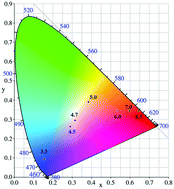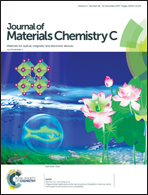CaF2:Eu films shine novel blue, white or red luminescence though adjustment of the valence state of Eu ions using the electro-deposition method†
Abstract
We report the fabrication of Eu-doped CaF2 films with an adjustable oxidation state of Eu ions such as Eu2+, Eu2+/Eu3+ or Eu3+ by the electro-deposition method, which are promising for luminescence converters for LEDs. Usually, the Eu2+ ion is unstable and can be very easily oxidized into the Eu3+ ion in solution. We reduced Eu3+ ions into Eu2+ ions by the electrochemical reduction method, and then incorporated Eu2+ ions into a CaF2 film during successive electro-deposition. We controlled the balance between Eu2+, Eu2+/Eu3+ and Eu3+ doped in the CaF2 thin film by regulating the parameters of the deposition solution (pH). More importantly, we controlled the luminescence from the Eu doped CaF2 film to generate pure blue luminescence, white luminescence, and red luminescence. These results not only provide a method for reducing Eu3+ ions into Eu2+ ions in solution, but also establish a new preparation technique for Eu2+/Eu3+ ion doped films and pave a new way for potential applications of Eu2+ doped luminescent materials.



 Please wait while we load your content...
Please wait while we load your content...